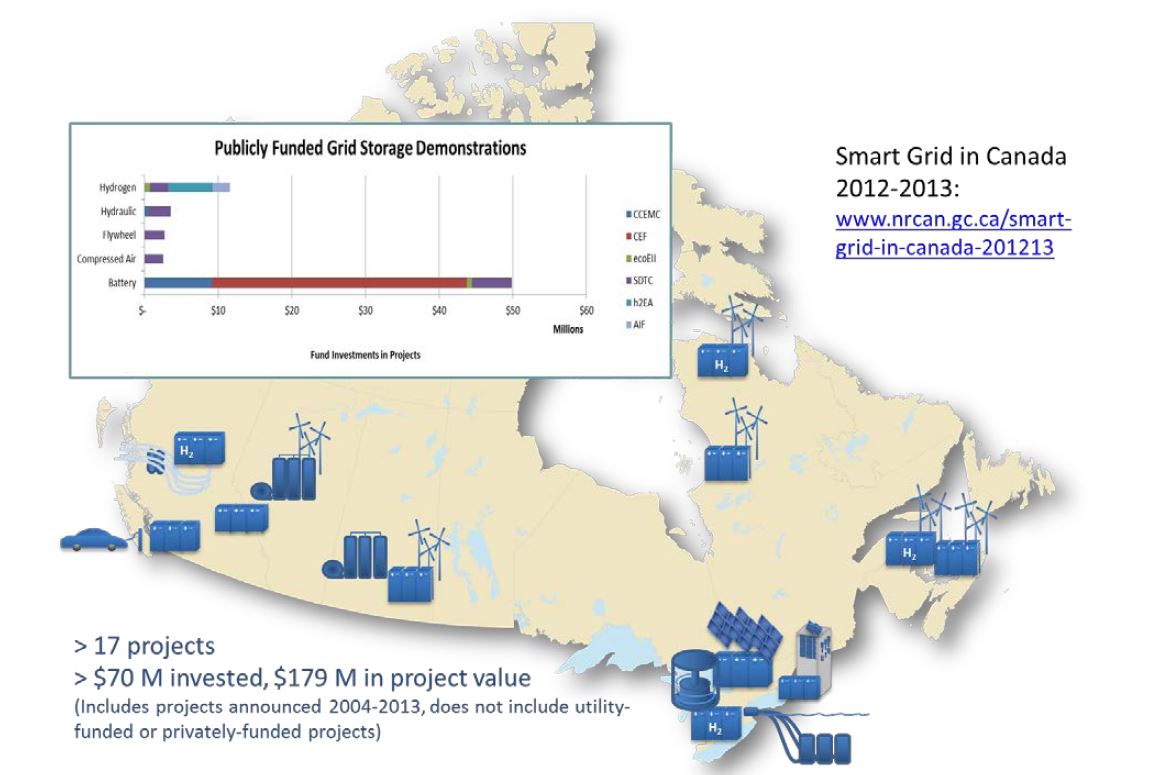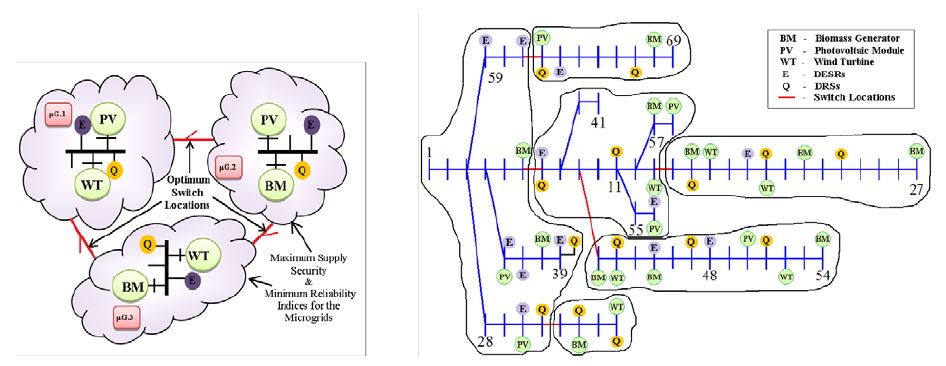CanmetENERGY Research Brief: Integrating Electricity Storage Into Smart Grid
Download full document (PDF, 515 KB)
Introduction
Lauded by many in the industry as the “holy grail” for enabling sustainable electricity systems, distributed storage technologies have garnered a lot of attention and investment over the last 10 years. In that time CanmetENERGY has tracked over $70 M in over $179 M in demonstration and pilot project value of storage projects across the country by various federal and provincial funds. NRCan has provided approximately 50 % of that funding, with additional research into the next generation of design and controls that will integrate storage technologies into more efficient, reliable and resilient grids.
Storage technologies can play a critical role in facilitating more renewable and distributed generation – but their positive impact is dependent on how storage technologies are integrated into the broader electricity systems and markets. CanmetENERGY has been conducting research on two main fronts: (1) on the impact of storage on operational costs and market dynamics, and (2) on the best ways to integrate them into smarter, stronger, fast-responding systems.

Figure 1: Publicly funded storage demonstrations & pilots in Canada
Text version
17 Canadian grid storage demonstration projects were publicly funded between 2004 and 2013. These projects have been funded for an amount of $179 million by various federal and provincial funds. $90 million of this amount was granted by Natural Resources Canada. CanmetENERGY tracked $70 million of overall funding.
Among the publicly granted funds, $11.5 million was invested in projects related to hydrogen, $3.5 million in projects related to hydraulic, $2.7 million in projects related to flywheel, $2.5 million in projects related to compressed air, and $50 million in projects related to batteries.
Measuring the Impact, Maximizing the Value
Creating the business case for electricity storage systems is a challenge because they have so many potential value propositions across energy systems. The main focus of research supported by CanmetENERGY in this field is measuring the impact of storage on electricity distribution systems and electricity markets. By delivering power and energy services to the grid and by enabling increased penetrations of renewable and distributed generation, storage can make electricity systems more efficient, reliable and resilient
Smaller can be Smarter, Stronger, Faster
CanmetENERGY researchers along with national and international partners have been developing the models and planning frameworks for utilities to convert the current top-down centralized control-schemes into more nimble automated control schemes. The microgrid concept is a self-sufficient zone of the larger distribution grid, which can operate when the rest of the grid goes down for extended, sometimes indefinite periods of time. The idea is that the distributed generation and controls of a microgrid can be a win-win-win for customer costs, increasing social resistance to large power plants, and new revenue streams as customers sell power back to the grid. This all makes it easier for utilities to invest in new infrastructure, and even increase reliability and resiliency.
Resiliency, or the speed at which the lights come back on after an outage, is something of growing importance to customers as we experience more severe weather such as ice storms, hurricanes and periods of extreme hot and cold. The “self-healing grid” has the ability to re-route power to affected customers and reduce the duration of an outage. The technologies used to create these resilient parts of the grid can restore customers to grid power or microgrid power, depending on the locally installed generation, customer power needs and storage technologies available. Storage technologies can help the many different components of smart grids and microgrids work together under different modes of operation by providing the balance between electricity supply and demand.
A new approach has been proposed for remote microgrids system performance enhancement and renewable resources integration that includes installing smart meters followed by system monitoring and real-time data collection (preferably for at least 1 year); next, assessing system performance and renewable resources followed by investigating and integrating suitable smart controllers and DR devices; then, selecting and integrating the appropriate technology and size for renewables and storage (if required); and finally conducting entire system performance assessments.
The Paradox of Choice
The other challenge with identifying the business case for storage technologies is that there are other technologies that can deliver the same services and value under a variety of circumstances that vary over time, and location. Furthermore, every electricity distribution system has its own set of characteristics, meaning that while no storage application is completely unique, no one storage solution will apply to every case either. This poses a real challenge for system planners to decide when and how to apply storage technologies within their system along with all of the other technology solutions available. For example, demand management such as load shedding (having customers agree to shut off power to certain loads), distributed generation can be used to provide services that storage can offer. Which technologies will provide the most value? Which technologies will cost the least to buy and to operate? Which services are customers willing to pay for and how will that change over time?
Researchers at the University of Waterloo, CanmetENERGY, and the University of Toronto have been working together to produce models for measuring the impact of storage on electricity marketsFootnote 1, distribution system reliabilityFootnote 2 , and the ability to integrate more distributed renewable generation Footnote 3. Once it has been determined what value storage can offer, the next challenge is designing and operating these systems to capture it. This research has developed methodologies for determining the appropriate size and location for storage technologies in order to get the maximum benefit for the least costFootnote 2, operational planning guides Footnote 3, control strategiesFootnote 5 and methodologies for allocating the various technologies under various conditionsFootnote 6,Footnote 4, Footnote 4 for determining the appropriate mix of technologies. Some of the findings include that:
- the benefits of arbitrage can be slightly higher for distributed storage than centralized storageFootnote 1,
- distributed storage can offer more benefits when located on feeders with higher residential and commercial loads than industrial loads Footnote 3,
- applying storage to a distribution system can reduce a utility’s annual costs more than load shedding alone can, because of their
Revolution and Evolution
The approaches to system design and operation described above represent a significant shift to the way we’ve traditionally thought about electricity systems today. However, many of the changes can be implemented in stages over the course of the ensuing decades. Researchers at CanmetENERGY and the University of Alberta have been looking at how power system planners and grid operators can use a building block approach to reliability and resiliency. Depending on the grid architecture and the local system needs, a self-healing grid could evolve into a cluster of interconnected microgrids capable of operating independently during outages. Or these interconnected microgrids could operate as “virtual microgrids” when there’s no outage, by solving power imbalances between supply and demand locally which can save on utility costs and save the customer from a lot of charges on their energy bill.

Figure 2: The diagram above is a line representation of electricity distribution system with distributed energy resources.
Text version
Line representation of electricity distribution system with distributed energy resources.
Coming up with a system architecture and controls that will optimize for improving system reliability and power quality is a challenge to say the least. Design strategiesFootnote 7 - Footnote 9 planning frameworks Footnote 7, and operation strategies Footnote 8 have been produced, with further publications anticipated for current research being conducted into the communications design for these systems. What these researchers have found is that integrating distributed generation, distributed storage, and distributed reactive sources that compensate for shifts in the power due to fluctuating generation and consumption of customer appliances can produce robust, cost-saving electricity networks. Not only that – it appears these designs can be scaled to allow for increases and decrease of both supply and demand as cities, towns and neighbourhoods develop over time.
The Best use of Necessary Investment
Canadian utilities and their customers are faced with some expensive capital investments over the next 10-15 years as much of the current electricity infrastructure reaches its capacity limits. At the same time, expanding markets for distributed generation, electric vehicles and smart appliances open opportunities for customers to gain equity and access new revenue streams to offset increasing energy costs. CanmetENERGY researchers and their partners are pushing ahead on solutions that allow the transition to more efficient decentralized electricity control and operation, while bringing down investment costs and even increasing reliability and resiliency.
Publication List:
Page details
- Date modified: